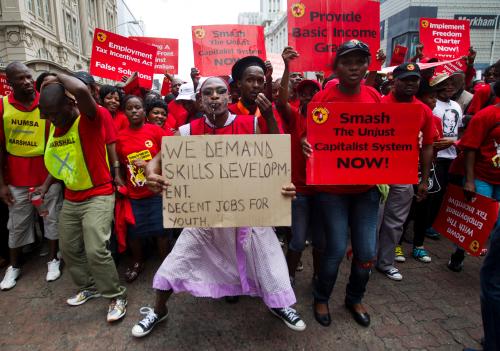Unemployment is a growing challenge around the world, though it is not a full-blown crisis yet. However, when the crisis comes, it is likely to erupt among urban youth.
While heading off such a calamity will not be easy, the global benefits of doing so would be great. As productive and socially responsible adults, the youth of today and in years to come could make planet Earth a better place for all.
A quick survey of the literature makes it clear that there will be no simple or universal solutions to the challenge of urban youth unemployment. The factors producing it are different in each city and useful interventions have to be well tailored to the cultural context.
Youth are the prime unemployment concern globally because their numbers are growing in most countries and because they are more prone to violence than adults. They have less to lose. Harvard professor Samuel Huntington made the point bluntly in an interview with journalist Michael Steinberger in The Observer on October 21, 2001: “Generally speaking, the people who go out and kill other people are males between the ages of 16 and 30.”
The first major outbreaks of violence by unemployed youth are likely to occur in cities because of the rapid pace of urbanization everywhere. The expectations of people in rural areas seem too low and their dispersion too great to create a combustible moment. Subsistence existence is normal there.
Fortunately, there are a number of counter currents. Demography may be the most important. Fertility is falling around the world. Women need to have 2.1 children on average to maintain a stable population size. After rising rapidly in the 20th century due to modern medicine and public health, fertility began falling below 2.1 in high-income countries in the 1970s and in the middle-income countries in the 1990s. Maybe fewer young people in the future will reduce the threat of social disorder.
According to World Population Prospects 2017 published by the United Nations, the mid-range forecast for global population in 2050 is 9.8 billion, up from 7.6 billion in 2015. Fertility in high-income countries is projected to remain below replacement level, stuck around 1.80 in 2050. Fertility in the upper middle-income countries will be only slightly higher at 1.82. For the lower middle-income countries, the largest of these four groups, fertility will be 2.25 in 2050, significantly down from 2.88 in 2015. It is the low-income countries, primarily in Africa, that have been and will continue to be the major source of global population growth, even as their fertility rate is projected to drop from 5.0 in 2015 to 3.08 in 2050. Despite this impressive fall, the population of this group of countries is on track to more than double from 600 million in 2015 to 1.4 billion in 2050.
It is possible that fertility will decline faster in the low-income and lower-middle income countries than the U.N. is projecting. As a result, combined with war and disease, the size of the global youth cohort, 15-24 years of age, could start shrinking by 2050. With continuing migration of youth from rural to urban areas, however, urban youth unemployment could be rising in these countries even as the number of youth is falling.
The other major cross current is that governments and the private sector are focused on creating more good jobs for youth. The leading sources of information and discussion about youth employment are the International Labor Organization based in Geneva, Switzerland, and the World Bank based in Washington, D.C. Both sources are promoting research on effective interventions and ways to scale these up.
Youth employment is also on the agenda of the G-20 Summit process, under the G-20’s Framework Working Group on the Future of Work (co-chaired by India and Canada). This week the ILO is convening the first global conference on “Innovation for Decent Jobs for Youth.”
The extensive academic research on youth unemployment highlights the complexities of the global challenge. For example, the expectations and education of youth vary tremendously between high-income and low-income countries. At the same time, the capacity of governments to mount effective programs varies greatly. Furthermore, the interests of international nongovernmental organizations and multinational corporations do not always align with the countries of greatest need.
There is a thriving universe of programs seeking to prepare youth for employment through a variety of training and job market activities. Most governments in the world are supporting at least one form of a youth employment program, from volunteer service to tax benefits to matching employers with youth. A multitude of international and domestic NGOs are working in this space. One of the oldest is the International Youth Foundation based in Baltimore, Maryland. Leading multinational corporations have put youth employment at the center of their corporate social responsibility programs, including CitiGroup, the Conrad N. Hilton Foundation, Mastercard Foundation, and McKinsey & Company.
So far, however, assessments of these interventions have found few that have a major and sustained impact on employment, or can be scaled up easily, or can be replicated effectively in other cities.
A major complication is the pace of technological and social change. From one year to the next, the world has gone from seeing social media almost as a panacea to being a threat to civil order. The work place is changing before our eyes, with the gig economy growing while full-time, long-term employment with benefits is stagnant or shrinking.
Is enough being done to avoid an urban youth unemployment crisis before 2030, the benchmark year for the U.N.’s 17 Sustainable Development Goals? Goal 8 is especially relevant; it includes “full and productive employment and decent work for all.”
What kinds of programs seem to have the potential for mitigating the risks of a crisis and can be scaled up or replicated across cities? Is it enough to focus on preparing youth for jobs or will it be necessary to tackle directly the potential for youth violence in cities and even redefine our visions of work?
An attempt will be made over the coming year to answer these questions in an effort to make sure that the global policy community is giving the challenge of urban youth employment the attention it deserves.







Commentary
Urban youth unemployment: A looming crisis?
May 2, 2018